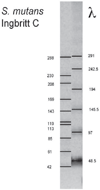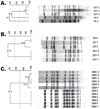Maternal transmission of mutans Streptococci in severe-early childhood caries
- PMID: 19552223
- PMCID: PMC3173944
Maternal transmission of mutans Streptococci in severe-early childhood caries
Abstract
Purpose: This study utilized multiple genetic analyses to detect evidence of maternal MS acquisition in children with S-ECC.
Methods: Twenty-seven mother/child pairs were selected from children with 5-ECC preceding dental rehabilitation under general anesthesia. Plaque samples were collected from the mother, child, and the child's carious lesion. Arbitrarily primed-polymerase chain reaction (AP-PCR) genotyped 6-8 MS isolates from each plaque sample, and unique genotypes were identified. Representative MS isolates with unique genotypes were characterized by pulsed-field gel electrophoresis (PFGE). Cluster analysis using the Dice band-based similarity coefficient was used to generate dendrograms from gel bonding patterns. A Dice coefficient >70% indicated similarity or match among PFGE genotypes.
Results: In 26% (7/27) of mother/child pairs, all of the child's isolates matched the mother. In 15% (4/27), some of the child's genotypes matched the mother, and in 59% (16/27), no isolates matched the mother. Maternal transmission was a mode of MS acquisition in 41% (11/27) of mother/child pairs, while acquisition from non-maternal sources occurred in 74% (20/27).
Conclusions: MS genotypes that did not match maternal strains were identified in the majority of children (74%) within this S-ECC population. Evidence of maternal transmission was detected in 41% of mother/child pairs.
Figures








References
-
- Li Y, Caufield PW. The fidelity of initial acquisition of mutans streptococci by infants from their mothers. J Dent Res. 1995;74:681–685. - PubMed
-
- Kulkarni GV, Chan KH, Sandham HJ. An investigation into the use of restriction endonuclease analysis for the study of transmission of mutans streptococci. J Dent Res. 1989;68:1155–1161. - PubMed
-
- Emanuelsson IR, Li Y, Bratthall D. Genotyping shows different strains of mutans streptococci between father and child and within parental pairs in Swedish families. Oral Microbiol Immunol. 1998;13:271–277. - PubMed
-
- de Soet JJ, Bokhout B, Buijs JF, van Loveren C, de Graaff J, Prahl-Andersen B. Transmission of mutans streptococci between mothers and children with cleft lip and/or palate. Cleft Palate Craniofac J. 1998;35:460–464. - PubMed
-
- Emanuelsson IM, Wang XM. Demonstration of identical strains of mutans streptococci within Chinese families by genotyping. Eur J Oral Sci. 1998;106:788–794. - PubMed
Publication types
MeSH terms
Substances
Grants and funding
LinkOut - more resources
Full Text Sources
Medical

